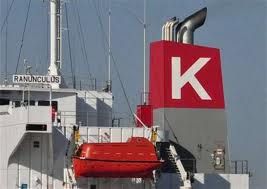
Kawasaki Kisen Kaisha Ltd. (9107), Japan’s No. 3 container line, said it may take as long as a year to decide on plans for adding larger vessels, even after its two main
local rivals signed deals to add big box ships.
“We’re not in a hurry,” President Jiro Asakura said in an interview in Tokyo on June 29. “We will use large container ships in line with the industry trend, but we’re going to think about when and how.”
A delay will let the company assess the market and work out the best mix of chartered and purchased vessels, Asakura said, without elaborating on how many ships it may add. In the past two months, Mitsui O.S.K. Lines Ltd. and Nippon Yusen K.K. have both agreed to contracts for vessels that carry more than 10,000 containers to help pare operating costs.
“Larger ships are more fuel-efficient, but they are very difficult to fill,” said Ryota Himeno, an analyst at Mitsubishi UFJ Morgan Stanley Securities Co. “It may pay to take your time and ensure you have the customers for the extra capacity.”
A total of 167 vessels able to carry 10,000 twenty-foot containers or more are on order worldwide, according to data from shipbroker Clarkson Plc. This year, A.P. Moeller-Maersk A/S has ordered 20 vessels able to carry 18,000 boxes, which will be the biggest afloat.
K-Line’s container unit accounts for about 45 percent of sales at the company, which also operates commodity vessels and car transporters.
Shedding Capesizes
The company’s shares fell 0.7 percent to 278 yen at the 3 p.m. close of trade in Tokyo today. K-Line has tumbled 22 percent this year, compared with an 18 percent decline for Nippon Yusen and a 22 percent drop for Mitsui O.S.K.
In its dry-bulk business, K-Line plans to sell “a few” of its 80 capesize ships because of plunging rates, Asakura said. The vessels to be shed will be among the 10 the line operates in the spot market, he said, without elaborating on a time frame for a sale.
Spot rates for capesizes have tumbled because of slowing demand in China and a surge in new vessels entering service. That has prompted shipowners to scrap 48 capesizes this year through June 24, more than double 2010’s full-year tally of 18, according to Clarkson. Capesizes carry about 170,000 tons of cargo on average.
Container Surcharges
Shipping lines also face higher costs after fuel prices jumped 54 percent in the past 12 months alongside an increase in oil prices. K-Line’s container arm plans to raise rates by $300 per 20-foot box on European routes from Aug. 1 to help recoup rising costs, Asakura said. It will also levy a peak-season surcharge of $400 per 40-foot container on U.S. routes from July 15, he said.
Still, the company expects current profit at its container division to slump to breakeven in the year ending March 31 from 29 billion yen a year earlier, when demand surged following the end of the global recession.
The company’s car-shipping division will likely make a loss in the six months ending September, Asakura said, after Japan’s March 11 earthquake disrupted auto production. Vehicle exports plunged 68 percent from a year earlier in April, the biggest drop since the Japan Automobile Manufacturers Association began keeping figures in 1973.
The unit, whose customers include Toyota Motor Corp. and Honda Motor Co., will likely make a profit in the second half of the fiscal year ending March, Asakura said.
“We won’t have a problem returning to the black,” he said. “The automakers are moving back to full production.”
Source: Bloomberg
We use cookies to improve your experience. By continuing to use our site, you accept our Cookies, Privacy Policy,Terms and Conditions. Close X